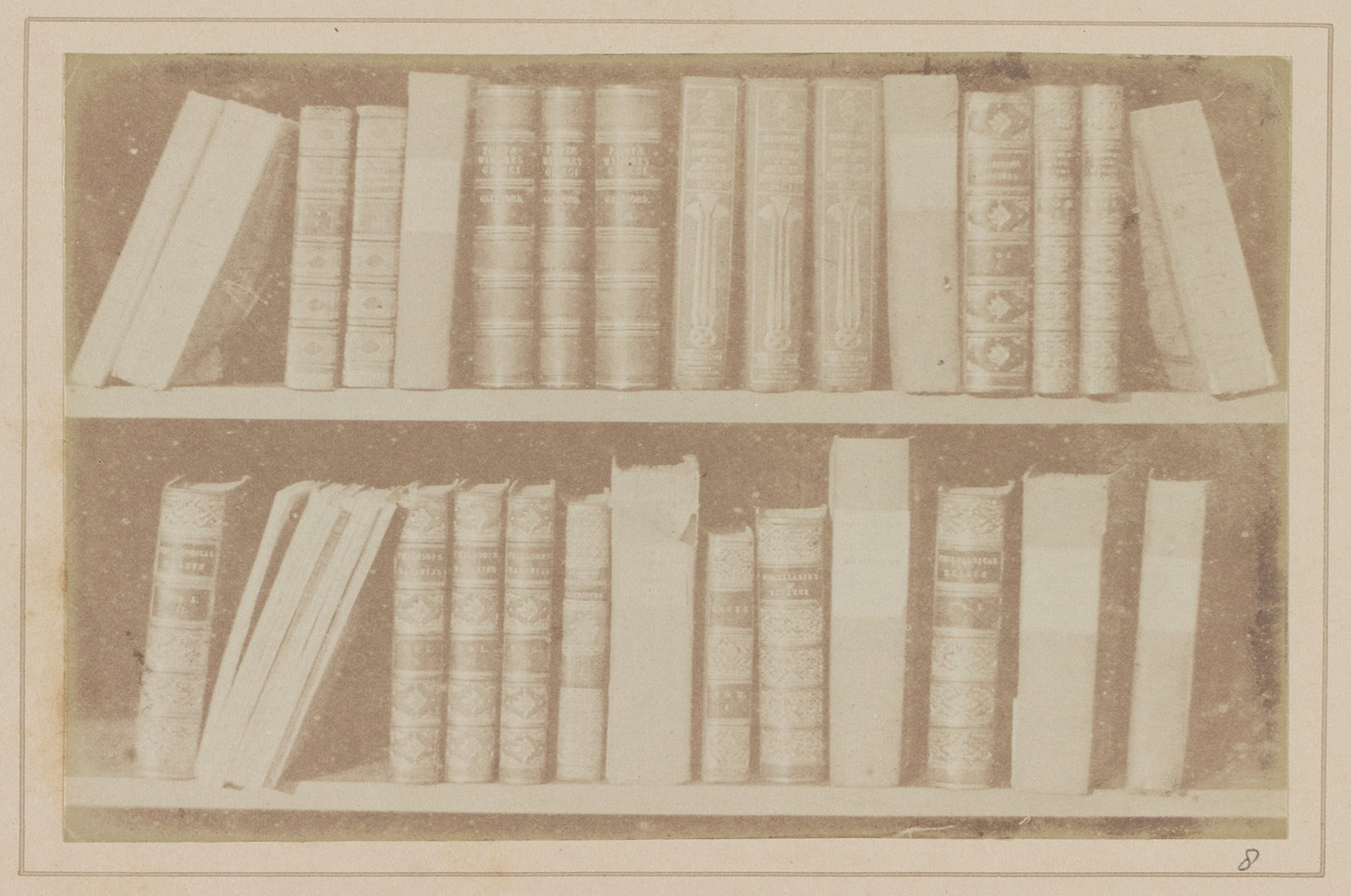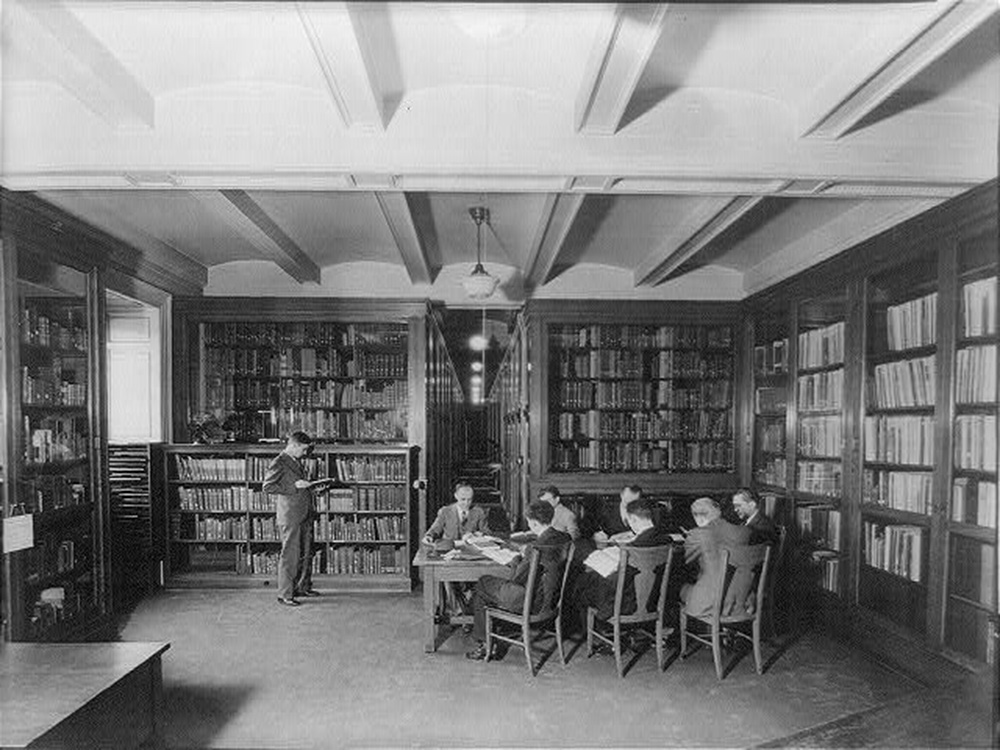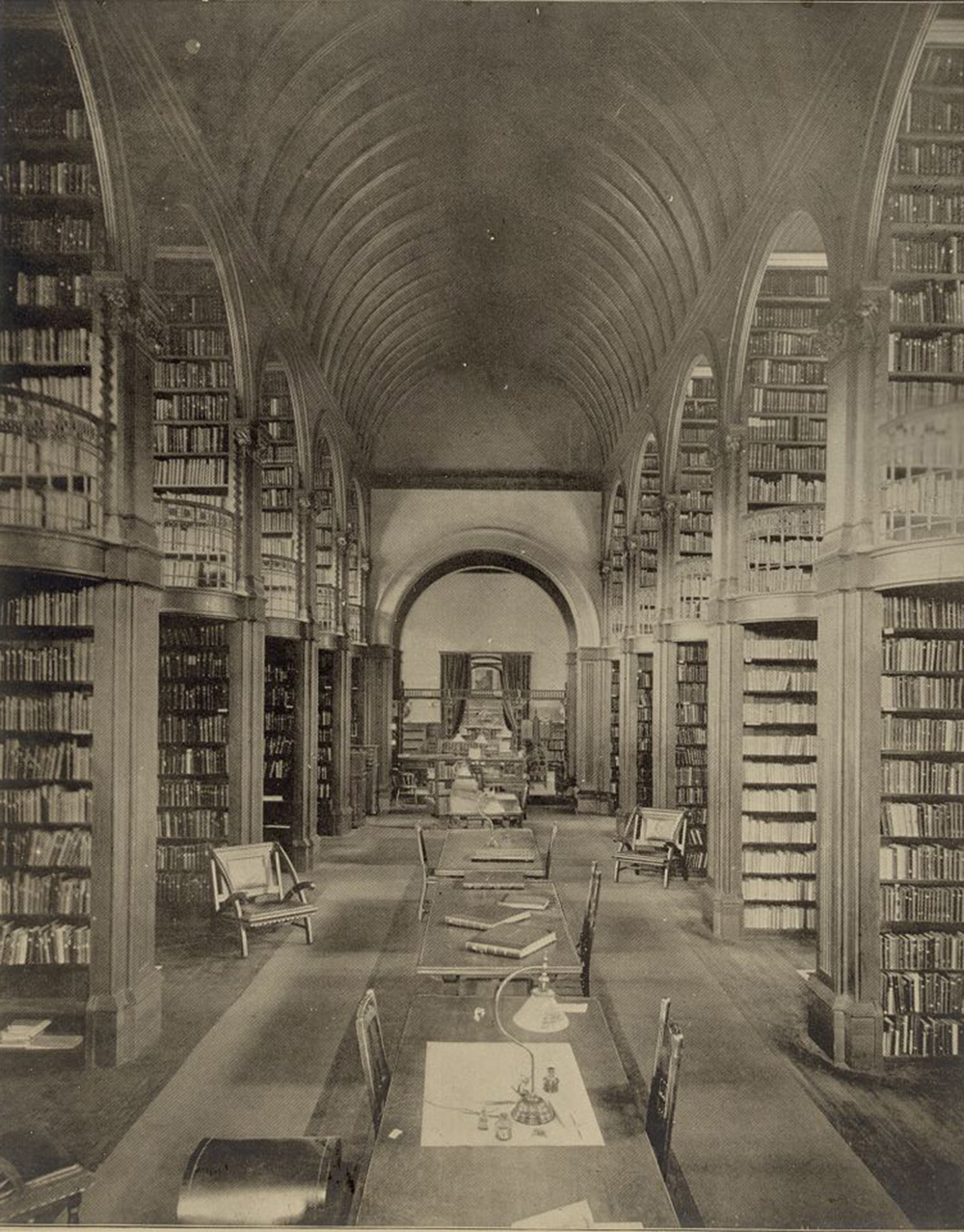
A Scene in a Library, by William Henry Fox Talbot, c. 1844. The Metropolitan Museum of Art, Gift of Jean Horblit, in memory of Harrison D. Horblit, 1994.
The lure of the ancients suggested to William James some ways to use his education, but where would that education lead—what particular intellectual stances, what line of work, and what fate for his personal life, his physical and mental health, and even prospects for marriage? He hoped his eighteen months in Europe from 1867 to 1868 would bring him out of his vocational and intellectual doldrums. Europe, however, was not the panacea that James hoped it would be. The baths did not cure him, and exposure to German science did not deliver him from his uncertainties—and neither could save him from a depression so deep it paralyzed his will to work and occasionally even his will to live. He returned from Germany at age twenty-six with good command of the German language but with little fluency in his own art of living. His intersecting and confusing burdens kept him in the same unsettled state until at least 1873. Through it all, he kept a constant drive to heal his mental and physical health, solve his dilemmas, and gain some personal and intellectual direction, especially through his ravenous appetite for learning.
James’ relentless curiosity, abundant reading, and intellectual reflections gave him a capacity to reach outside of his own discouragements. When depressed, he did not become inert, but searching; as he said to his brother Henry even in 1870, being “idle” would for him be “no easy work as you know.” His long book lists display his intellectual ambitions. In addition to his scientific texts, he set out to read not only Homer and Marcus Aurelius but also portions of Cicero, Tacitus, and Saint Augustine; Voltaire, Auguste Comte, and Ernest Renan; works on ancient religion and modern Buddhism, including Émile-Louis Burnouf’s La Science des Religions, Étienne Vacherot’s La Religion, Henry Alabaster and Chao Phya Thipakon’s The Modern Buddhist, and Karl Friedrich’s Die Religion des Buddha; Immanuel Kant and Charles Renouvier; Hippolyte Taine and George Sand; Herbert Spencer and John Tyndall; Oliver Wendell Holmes Sr., Nathaniel Hawthorne, and Margaret Fuller; Benjamin Franklin and Captain John Smith; Horace Bushnell and John Fiske; Thomas De Quincey and Thomas Carlyle; E.B. Tylor and John Henry Newman; Emanuel Swedenborg and his own father. In the late 1860s to early 1870s, the very years of his worst discouragement, he turned to these works for “the relaxation of the mind [away] from that high-strung attitude of vigilance…and suspended judgment…[of the scientific] investigator.” Anticipating his impatience with such scientific caution when faced with genuine and ambiguous options in “The Will to Believe,” young James already found that this avocational interest, like any one of his water-cure visits, also “reinvigorates and disposes for future exertions.”
Through crises and constructions, James learned to manage his need for both effort and rest, with reading for work and for enjoyment. The full fruits of both kinds of learning would not come all at once, as he alternated between bleak feelings and genuine vigor. The whole process took a painfully long time; his own pace of maturation provided a personal version of the significance of long-term thinking that he had been learning from his friend Charles Peirce. The delays in James’ coming of age suggest a long gestation period in the development of his talents, as psychologist David Galenson observes about “late bloomers” who search, experiment, and despair many times on their path to achievement. A biographical perspective on James’ theories suggests that these were postponements with a purpose, even if he could not detect the purpose at the time—paraphrasing his later thinking, these purposes were still in the making.

A general account of James’ childhood would give little indication of the impending dark moods of his young adulthood. As the oldest child, bright and often very funny, William was wholly confident. This frequently manifested in what his own son called “an intimate raillery” with his “fun and extravagant” comments on friends and family. Once when he was “composing odes to all the family,” his sister Alice said in jest that “he is fit to go to the lunatic asylum.” This intensity, along with tendencies to ask large questions, would loom more significant after childhood. At age fifteen, he already started to brood about his future profession. His first “taste” was to “pursue some scientific occupation,” and his family encouraged this impulse not just with a microscope for a Christmas present but also with science classes at the various schools of his childhood. However, in the next few years, he grew more and more “torment[ed]” by the “choice of a profession.” He took a particular interest in a quotation from Jean-Jacques Rousseau that he saw posted at his school in Boulogne, France, in 1858: “Life is gone in an instant. In itself it is nothing. Its value depends upon the use to which you put it.” He could not yet imagine the pragmatic suggestions in these ideas, but he surely would have already noticed the expression of his father’s philanthropy with its Swedenborg-inspired commitment to social use. By 1858, he was already feeling fretful, “for all time spent working in the wrong direction is lost,” and this was even before the decade and a half he would take to find his direction. In the spirit of mid-nineteenth-century American defiance of authority, as amplified by his father’s independent spirit and insistence on philanthropic work, young James was skeptical of institutions in his eagerness to serve mankind for making the world a better place. This impulse would also extend into his young adulthood, into his eagerness to support useful applications of his science and philosophy, and into the reform sympathies of his mature life as a public intellectual. His youthful search for meaningful work was intensified, and postponed, by his search for philanthropic purpose. So his education involved a search for ideas with theoretical and therapeutic appeal; but before he could help others, he needed to find his own direction.
Worry over career choice was compounded by hints of melancholy as early as 1859. James’ notebook of that year contained aphorisms, personal sayings, and general observations, which also displayed his interest in romanticism and the ancients. One example is full of black humor: “Earth = host who murders his guests,” a translation of the medieval Persian poet Divan of Hafiz that he had likely learned from Ralph Waldo Emerson. In his notebook of 1862, after pages of intellectual wrestling and vocational indecision, James made this arrestingly simple statement: “Life itself is what is most valuable in life.” This suggestion about living vitality, which he was encountering in the homeopathic vital force and the conatus of Swedenborgians such as his father (and taken up in the twenty-first century by Antonio Damasio) provided a hint of his emerging concept that materialistic views of biology and psychology, which emphasize reductionist physical and chemical explanations, would not be sufficient. Despite the vigor of this comment, the next page of the notebook included this blunt comment, “Suicide morally & really considered.” He did not specify whether this was a comment on himself or not; nevertheless, it indicates that he was aware of this darker side of life even as he affirmed the importance of vitality in general.

James kept writing in that same mood later in 1862, when he began a notebook of reading notes and deep thoughts with these bold, religiously inflected words:
SON OF MAN! STAND UPON THY FEET AND I WILL
SPEAK UNTO THEE
The all-caps screaming on a notebook page otherwise mostly blank suggests a potent intent. The Bible uses the phrase “son of man” many times, especially in the book of Ezekiel, where it appears more than ninety times, and in the New Testament, more than eighty. Ezekiel displays confidence in his mere humanity before serving as a messenger from the divine. The prophet then challenges the “rebellious people” of Israel, so “impudent…and stiffhearted,” and pledges to serve as a “watchman” preaching for a reversal of wicked ways. In the New Testament, Jesus’ use of this phrase to describe himself suggests the elemental power even in someone of low worldly status, even if persecuted to death. For the New Testament evangelists, the “son of man” points to the Messiah’s incarnation with divine immanence within human flesh, and to the hopes for his triumph over death and return as judge: “Hereafter shall ye see the Son of man sitting on the right hand of power.” The biblical references in a private notebook suggest that James is referring to himself, awaiting a commission to high purpose, with a hope that bleak times could lead to later achievements; even when weak or beleaguered, he must find strength, but who is issuing the commission?
After the thunderous command about the son of man, James went on to declare brashly,
HEARTILY KNOW
WHEN THE HALF GODS GO
THE GODS ARRIVE.
These words, again inspired by Emerson, suggest a posture of sorting through religious claims. In his poem, “Give All to Love,” Emerson urges readers to “Obey thy heart,” which “ ’tis a god” and “Knows its own path,” before offering condolences when a love is lost: “Tho’ her parting dims the day,” hope endures, but only through “Stealing grace from all alive.” James’ forlornly uncoupled state and his eagerness to find ways to manage his troubles would have made him receptive to such hopeful words, especially when delivered with ideas akin to his search for finite absolutes as reinforced both in Friedrich Schiller’s tribute to grace and in Emerson’s unchurched spirituality of the god within and grace in all alive. The poem then concludes with the irreverent intonation that James quotes in full. The young scientist turned the poetic reference into a banner declaration of his goals: he was setting out on a path of reflective searching, which would soon become disruptive and troubling, but these would be first steps toward more reliable guides to life.
Excerpted from Young William James Thinking by Paul J. Croce. Published by Johns Hopkins University Press © 2017. Reprinted by permission of the publisher.
Read more on the mind in our Winter 2018 issue, States of Mind.